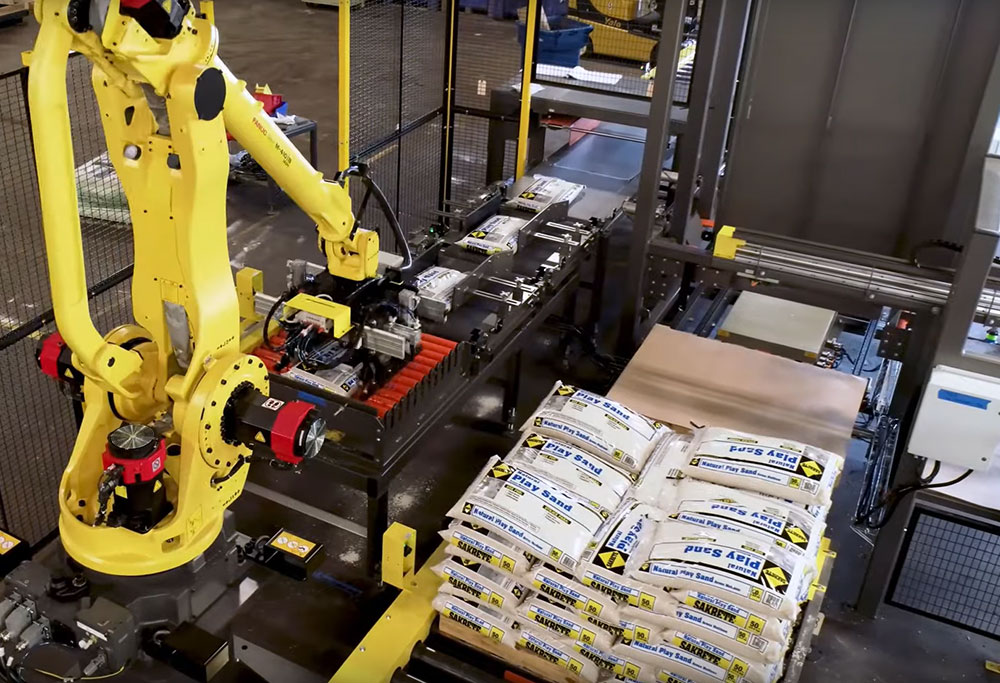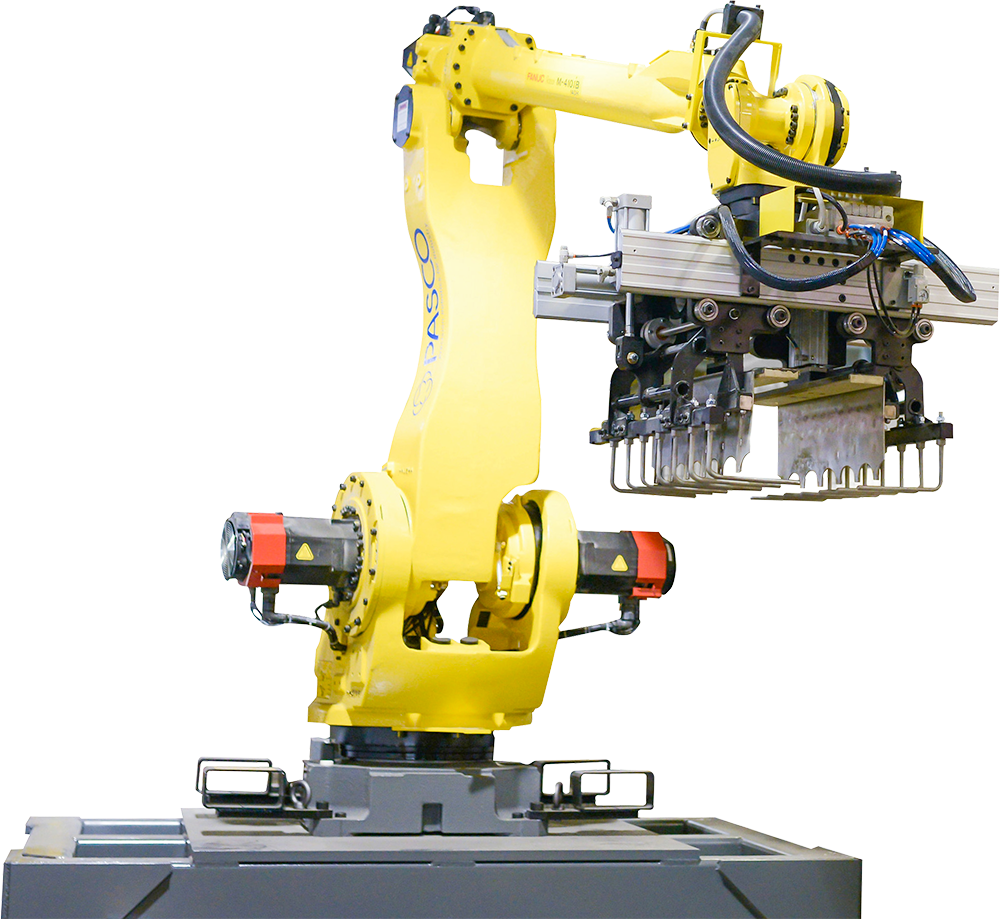A single automated palletizing cell can reduce labor costs for the production line by up to 50% while boosting line throughput by more than 35% within months of installation. Robotic palletizing uses industrial robots, conveyors and custom end-of-arm tooling to stack cases, bags, pails and beyond onto pallets with consistent speed and placement.
In this guide, we’ll cover:
- The key benefits driving ROI, safety and quality improvements
- The varieties of palletizing robots from six-axis articulated arms to collaborative cobots
- How custom end-of-arm tooling (EOAT) tailors each system to your product mix
- The steps for seamless integration with upstream and downstream equipment and software
- How PASCO®’s five decades of automation expertise ensures system performance and lifecycle support
Key benefits of robotic palletizing
Robotic palletizing delivers a combination of continuous operation, precise handling and programmable versatility that enables end-of-line packaging to be a lean, error-proof process.
By replacing manual stacking with automated systems engineered for harsh environments, manufacturers gain measurable improvements in operational efficiency, employee safety and product quality, all while reducing labor costs.
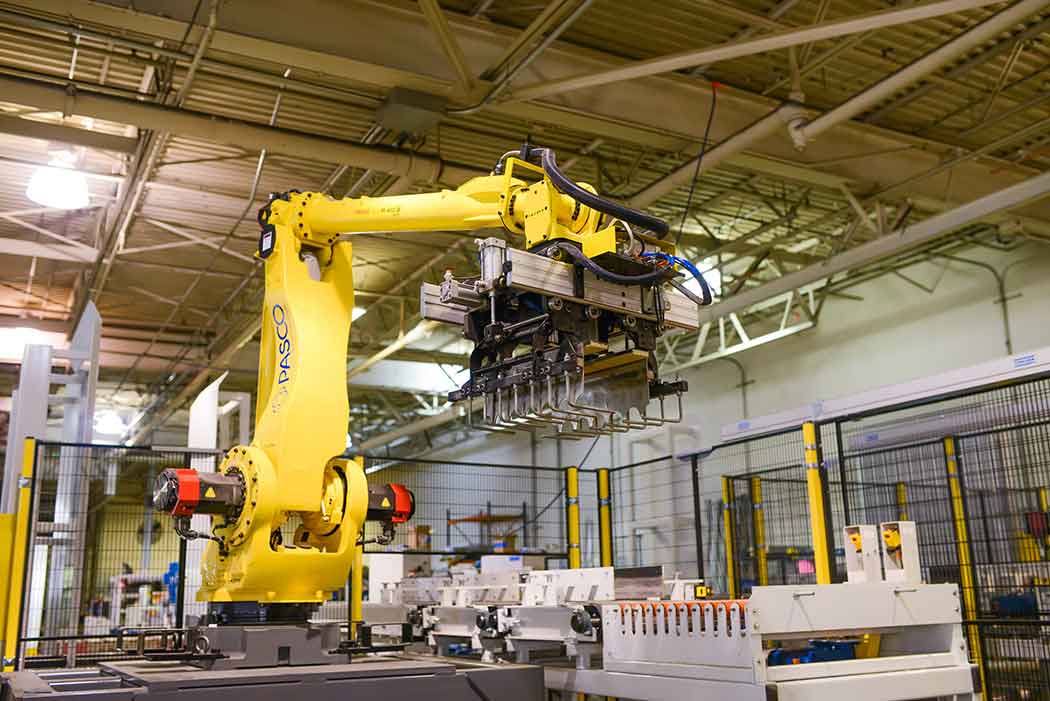
Efficiency and throughput gains
Modern robotic palletizers maintain consistent cycle times and eliminate variability from shift changes or fatigue. Performance depends on product type, tooling, and system design, but:
- Cycle speed: many industrial systems can complete multiple pallet patterns per minute under standard conditions
- Shift capacity: in an 8-hour shift, automated palletizers can stack thousands of layers without interruption
- Automation scope: systems also handle pallet dispensing, pattern changeovers and pallet removal automatically
Financial Impact and ROI
What is the typical ROI period?
Automated palletizing can significantly reduce labor costs and boost line throughput. Studies show that companies can see a return on investment within 2-3 years due to labor savings and increased efficiency.
This research supports the article’s claims about the financial benefits and efficiency gains of implementing robotic palletizing systems.
In what ways does robotic palletizing reduce labor costs?
Automated palletizing systems relieve labor from repetitive, ergonomically taxing tasks and allow redeployment to higher-value functions. Over a five-year period, companies often see a return on investment through labor savings that exceed initial capital outlay.
Below is an example cost comparison of manual versus robotic palletizing:
Robotic palletizing reduces annual labor expenses by nearly $330,000 while delivering payback within 24–36 months. These savings translate directly to improved profit margins and redeployment of skilled workers to system operation, maintenance or quality control.
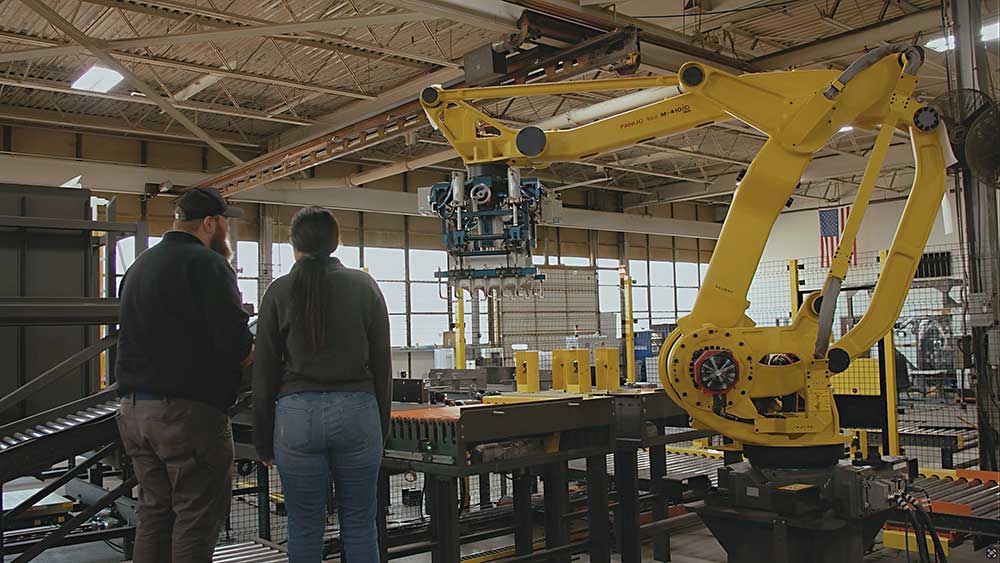
Workplace safety and compliance
How does robotic palletizing enhance safety?
Robotic systems eliminate repetitive manual lifting of heavy loads, preventing musculoskeletal injuries and significantly reducing workers’ compensation claims. Integrated safety fences and light curtains create protective zones that isolate high-speed motions.
Safety enhancements
- Eliminates repetitive heavy lifting, reducing musculoskeletal injuries.
- Integrated fences and light curtains create protective zones.
- Isolates high-speed robotic motion from human workers.
- Compliance with OSHA, MSHA, and ISO standards.
- Cuts incident rates by over 70%.
Accuracy and product quality
Robotic palletizing ensures superior load stability and product integrity through advanced precision and handling.
- Precision-programmed stacking patterns: Eliminates human error in layer orientation.
- Consistent EOAT grip pressure: Prevents crushed cartons, punctured bags, or unstable loads.
- Advanced vision systems: Adapts to height differences and irregular product shapes.
- Improved load stability: Reduces shrinkage and damage across the supply chain.
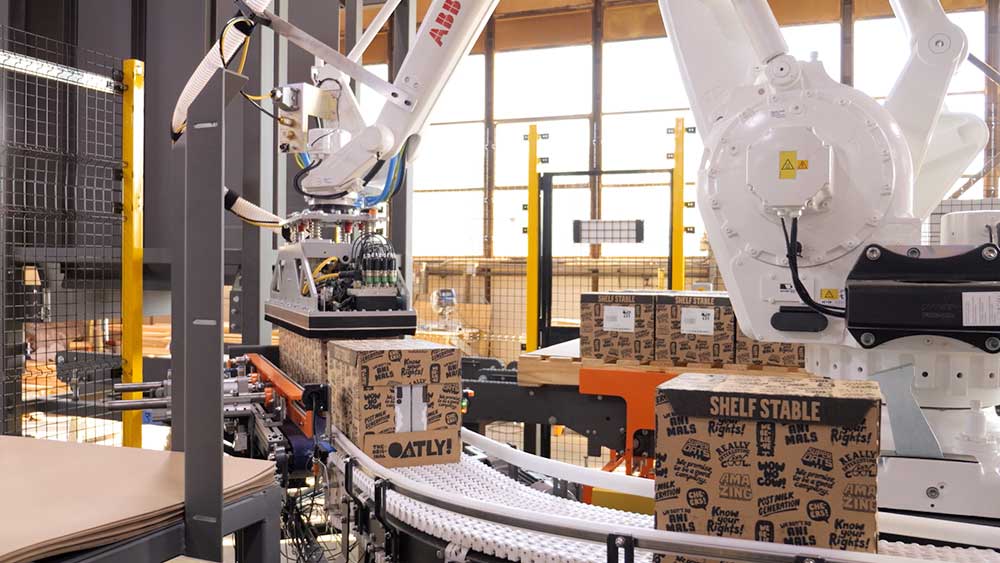
Types of robotic palletizers offered by PASCO®
PASCO® engineers custom robotic palletizers in a variety of configurations to match space constraints, payload requirements and throughput targets. We are an authorized integrator for FANUC, ABB, Kawasaki and Yaskawa, ensuring integration capabilities to match any existing production line.
How do collaborative robotic palletizers (cobots) work safely with humans?
Collaborative robots use force-limited joints, integrated safety sensors and responsive stopping algorithms to operate alongside workers without traditional guarding. Cobots handle much lighter payloads (often up to 20 kg) and are ideal for limited-throughput lines where human oversight or manual loading is required. Safe-speed settings and proximity detection create dynamic safety zones that pause robot motion if a worker enters the cell, enabling flexible, mixed-mode operations.
End-of-Arm Tooling (EOAT)
How does EOAT customize performance?
End-of-arm tooling defines the connection between the robot and your product, making EOAT design critical to reliable pick-and-place performance. Our in-house tooling engineers design custom grippers and vacuum systems for bags for precise handling of boxes, bags, cases and pails, regardless of surface texture or fragility.
What are the different types of EOAT used in palletizing?
- Vacuum grippers that maintain sealed pick on flat, rigid surfaces
- Mechanical clamp grippers for irregular cartons and pails
- Soft bag grippers designed to cradle flexible packaging without puncture
How are custom EOAT designs tailored for diverse product handling?
We analyze product dimensions, packaging types and environmental factors (e.g., moisture, dust) to engineer end-of-arm tooling for your operation. By being a true OEM, we design and manufacture tooling in-house, allowing us to solve unique production challenges.
Integration in production lines
How do palletizers connect upstream and downstream?
A truly automated cell connects mechanical, electrical and PLCs with upstream and downstream equipment. We design turnkey solutions that dictate product flow, data exchange and safety interlocks across the entire end-of-line.
As a proud division of Pasco Systems Corp, we partner with our sister-company, Versatech, to design, manufacture and install end-to-end systems.
How do robotic palletizers connect with upstream and downstream equipment?
By integrating conveyors, pallet dispensers, case sealers and more, the palletizing cell becomes a continuous production segment. Standardized I/O protocols and safety relays ensure synchronized start/stop commands.
For example, a pallet dispenser downstream of a wrap station can automatically feed pallets into the robot cell at preset intervals, eliminating manual pallet loading.
Before you invest checklist
To determine if robotic palletizing is the right move, manufacturers should evaluate:
- Current labor costs: Annual spend on manual palletizing labor.
- Throughput targets: Required pallet patterns per hour or per shift.
- Floor space: Availability for robot cells, conveyors, and safety zones.
- Product mix: Range of sizes, weights, and packaging types.
- Safety compliance gaps: OSHA, MSHA, and ISO standards readiness.
- Integration needs: How the cell must connect with existing upstream/downstream equipment.
- Support expectations: Access to service, spare parts, and long-term lifecycle management.
This framework ensures decisions are grounded in measurable criteria rather than general benefits.
Why PASCO®?
With nearing 50 years of industrial automation experience, PASCO® combines engineering know-how, in-house manufacturing and 24/7 lifecycle support to deliver palletizing and end-of-line automation systems.
What experience and reliability does PASCO® bring to automation?
PASCO® has engineered thousands of custom robotic cells since 1976, solving complex handling challenges in food & beverage, chemicals, ice, building products and other production environments. A dedicated in-house fabrication shop and a team of seasoned field service technicians ensure rapid response to installation, commissioning and lifecycle support needs.
PASCO® differentiators
- 50 Years Experience: Engineering thousands of robotic cells
- In-House Manufacturing: Ensures precision and reliability
- Authorized Integrator: For FANUC, ABB, Kawasaki, Yaskawa
- 24/7 Field Service: Comprehensive support across North America
- Integrated Solutions: End-of-line expertise with Versatech™
Over five decades, PASCO® has honed best-practice methodologies and built proprietary tooling to ensure every robotic palletizer operates reliably in the harshest environments.
By combining leading robot brands with in-house engineering and 24/7 field service, PASCO® transforms manual palletizing bottlenecks into automated high-performance cells that deliver fast ROI and sustained productivity gains.
Ready to elevate your end-of-line automation?
Request a custom palletizing system quote from PASCO® today and discover how automation can optimize efficiency, enhance safety and maximize your cap-ex.
Common questions regarding robotic palletizing
Manufacturers frequently evaluate cost, system types, operational principles, industry fit, efficiency impact and integration scope when considering a palletizing cell.
How much does a robotic palletizer cost?
System pricing ranges drastically depending on the application, but systems start typically in the $300,000 range. Final cost depends on product or packaging type, cycle rate, integration complexity and required safety features. Contact our automation experts for a tailored quote that factors in your unique application and ROI goals.
What are the main types of robotic palletizers?
Robotic palletizers fall into three primary categories: articulated arms with six or more axes, collaborative cobots designed for human-robot work cells, and gantry-style robots for high-speed, overhead stacking. Each type offers different benefits in reach, payload and footprint.
How does a robotic palletizer work?
A robotic palletizer picks products from a conveyor using EOAT, aligns them according to a programmed pallet pattern and places each layer onto a pallet. Integrated features, like vision, slip sheet placement, pallet orienting and more, ensure consistent pick reliability and accurate stacking across diverse packaging types.
Which industries benefit most from robotic palletizing?
Food and beverage, ice, feed and seed, chemical products and building materials industries gain the greatest advantage from robotic palletizing due to high volume, repetitive packaging, strict quality requirements and labor-intensive processes.
Can robotic palletizers be integrated with existing systems?
Yes, modern palletizing robots interface with legacy conveyors, PLCs and warehouse management systems through standard protocols (Ethernet/IP, ProfiNet). This enables phased automation upgrades without complete line overhauls.

